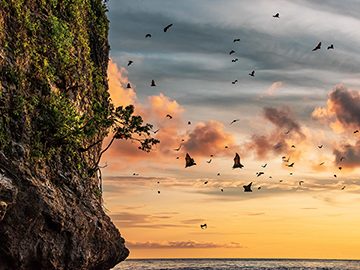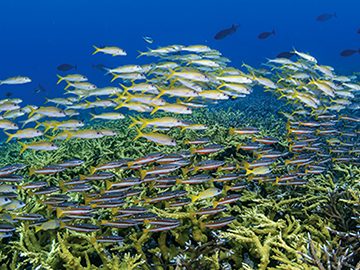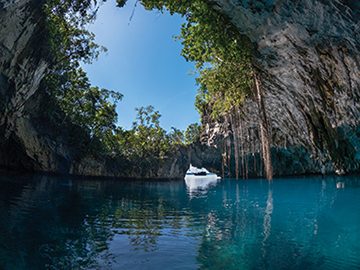Mengembangkan destinasi penyelaman baru
JSEBELUM MATAHARI TERBIT I make a cup of strong Indonesian tea and feel the familiar rush of anticipation that always builds when I dive where no one else has. From the liveaboard’s top deck I squint at a string of islands — just green dots from here — that stretch offshore from the Fakfak Regency, which lies between Raja Ampat and Triton Bay in Indonesia’s West Papua province.
My shipmates and I are here to explore this expanse of undocumented reefscape and find enough captivating activities to develop Fakfak for adventure tourism. Our goal is to add Fakfak as a dive destination among the region’s trinity: Raja Ampat, Triton Bay, and Cenderawasih Bay.
Our goal is to add Fakfak as a dive destination …
Before this trip, liveaboards traveling between Raja Ampat and Triton Bay had largely ignored Fakfak, which had only two recorded sites: one around Pisang, a small island group northwest of Fakfak, and another near Mommon, a spectacular waterfall in the south. But a destination needs more than a few sites. Travelers will look for locations that offer several days’ worth of diving and have maps and site descriptions available. Photographs and articles will create a buzz about the area. All the site organization and publicity, however, may still take a couple of years to convince people to travel halfway around the world to dive at the newest hot spot, so the development work must start early.
Having spent many years establishing resorts and liveaboards in remote areas, I’m well versed in most aspects of dive destination development. At this stage in my life I know I was fortunate to get to these places early and that my sense of adventure led me to introductions to the right people and made me willing to take a chance on diving in an uncharted area. Wanderlust took me to Mexico’s Quintana Roo coast in the early 1970s, the Solomon Islands in the late 1980s, and Komodo National Park in the early 1990s.
PENGEMBANGAN DAN PELESTARIAN
In late 2002 I headed to Raja Ampat after reading a rapid assessment survey that described the reefs surrounding West Papua’s Raja Ampat Regency as the most biologically diverse in the world. My first day of diving there confirmed it — I had never seen reefs like those.
While I was chartering liveaboards, a consortium of international nongovernmental organizations (NGOs) — including Conservation International, The Nature Conservancy, and World Wildlife Fund-Indonesia — worked closely with local communities and the government to form a conservation initiative. Known as the Bird’s Head Seascape (BHS), it included Raja Ampat, Triton Bay, and Cenderawasih Bay, Indonesia’s largest marine park. One of the initiative’s early successes was establishing the Bird’s Head marine protected area (MPA) network, which now consists of 26 MPAs covering more than 20,000 square miles (51,000 square kilometers).

kelompok untuk memberi makan saat matahari terbenam.
JONES–SHIMLOCK/SECRET SEA VISIONS

JONES–SHIMLOCK/SECRET SEA VISIONS
It didn’t take long for stories and photographs about Raja Ampat’s reefs to spread. By 2008 liveaboards were queuing at popular sites, and diver impact was noticeable. Mark Erdmann, PhD, Conservation International’s senior advisor for Indonesian marine programs at the time, offered me a dream job. I’d have access to a liveaboard, a couple of scooters, and a budget to explore the furthest reaches and publish a Raja Ampat dive guide. Mark believed that discovering additional sites would relieve diving pressure and encourage liveaboards to visit remote areas, where their presence could deter illegal fishing.
Diving Indonesia’s Raja Ampat keluar pada tahun 2009, dan buku panduan kedua, Diving Indonesia’s Bird’s Head Seascape, followed in 2011 and included Triton and Cenderawasih bays. Conservation International’s website for BHS (birdsheadseascape.com) menggabungkan semua informasi dari buku-buku tersebut dan menyediakan konten baru. Pengembangan pariwisata berkelanjutan menjadi bagian resmi dari strategi konservasi BLKB.
Saat kami berbelok, kami melihat seekor manta samudra yang besar dan penasaran mengikuti kami. Kami dengan lembut berputar kembali dan berlayar dengan manta, mata ke mata, untuk waktu yang sangat lama.
MENJELAJAHI FAKFAK
A light breeze was blowing as Mark joined me on the liveaboard’s top deck, carrying his ever-present French press travel mug. The COVID-19 pandemic had delayed this exploratory trip for two years, and the wait seemed interminable. Mark told me that the Fakfak government has anticipated our assistance in developing tourism opportunities since 2018. That year the Ministry of Marine Affairs and Fisheries had formalized the regency’s two new MPAs and the governor of West Papua had officially recognized the extension of the Bird’s Head MPA network.
“We surveyed this area from a biodiversity perspective in 2006 and again in 2018,” Mark explained. “We documented spectacular species diversity but didn’t focus on tourism potential. I feel confident the team we’ve got now will produce enough content to attract adventure tourism to Fakfak.”
Mark and I had assembled a dream team of intrepid divers focused on distilling this journey into the elements necessary to attract visitors to Fakfak. Besides flying a drone, photographing, and watching for new fish species, Mark would keep a journal of each dive site’s details. Also with us is my old buddy Gerald Allen, PhD, the scientist responsible for first calling attention to the region’s spectacular fish diversity and arguably the world’s foremost tropical ichthyologist. Sarah Lewis, a manta conservationist and founder of the Indonesian NGO Thrive Conservation, is here to assess the potential for shark and ray tourism development in Fakfak.
Kami memiliki tim yang bertugas memproduksi konten. Garry Bevan, warga Inggris yang tinggal di Indonesia, akan membuat peta lokasi penyelaman yang terperinci untuk situs web BHS. Joel dan Jennifer Penner adalah pengembang situs web, videografer, dan fotografer yang memiliki New Media Soup dan memberikan dukungan teknologi untuk situs web. Sebuah film promosi untuk pemerintah Fakfak berada di tangan Luca Vaime dan Mike Veitch, videografer dan fotografer asal Bali yang mengelola Underwater Tribe.

JOEL PENNER/SUP MEDIA BARU

JONES–SHIMLOCK/SECRET SEA VISIONS
LSM lokal Konservasi Indonesia memiliki tim yang luar biasa untuk menginterpretasikan temuan-temuan kami kepada pemerintah Fakfak dan masyarakat setempat serta memberikan masukan mengenai potensi pariwisata domestik. Dipimpin oleh direktur program Papua Barat, Meity Mongdong, dan manajer koridor Kaimana-Fakfak, Ismu Hidayat, tim ini terdiri dari Meidarti Kasmidi, Susan Vulpas, Permenas Mambrasar, Bertha Matatar, Yakonias Thonak, Johanis Toisuta, serta mitra kerja Ramlie Salihi (kepala Otoritas Pengelolaan KKP Fakfak) dan Isak Samori dari Kementerian Lingkungan Hidup dan Kehutanan Papua Barat. Banyak anggota tim yang telah berada di garis depan dalam mengembangkan inisiatif BLKB selama hampir dua dekade.
Edi Frommenwiler, the liveaboard’s owner, steps from under the canvas shade to watch the current patterns streaking the sea’s smooth surface. He was also with us for the initial 2002 Raja Ampat survey. He agrees we should check out a labyrinth of reefs that our ancient charts tell us are just off the bow. Mark decides to launch his drone for a quick aerial survey before the diving day begins. After a short flight, Mark quickly downloads the images. Visibly excited about the seamount his drone footage reveals, he says, “I think we should concentrate here, where the current is strongest, and there might be some schooling fish action.”
Saya dan Edi setuju dan mulai memobilisasi tim untuk mengisi setiap sampan. Semua orang, terutama kontingen Indonesia, bergerak perlahan. Kami begadang beberapa malam, menari dan bernyanyi bersama penduduk lokal di Kokas dalam sebuah pesta penyambutan yang mewah di pantai. Dan tadi malam, liveaboard menjadi tuan rumah makan malam untuk wakil bupati Fakfak, dan tim Indonesia kami berbincang hingga larut malam tentang hasil survei yang dapat menarik minat wisatawan: air terjun yang spektakuler, petak-petak hutan tua, gua batu kapur yang mengesankan, dan taman-taman karang dangkal yang indah yang cocok untuk perenang snorkel.

Spesies baru taring blenny (Meiacanthus sp.)
GERALD ALLEN
Saya akan membawa sekoci untuk diri saya sendiri, satu-satunya penumpang saya adalah skuter bawah air. Meskipun fotografi adalah minat saya, misi saya adalah menjelajah, jadi saya hanya memiliki sedikit kesempatan untuk membawa kamera. Penyelam lainnya mengisi dua perahu lainnya. Setiap kapal membawa GPS, dan pengemudi menandai titik masuk dan keluar. Pemandu selam akan muncul ke permukaan jika mereka menemukan area yang ramai, dan pengemudi kapal tahu untuk menandai titik-titik ini.
After grabbing a piece of toast for breakfast, I’m ready to investigate the area Mark suggested. By the time I pull away my boat, Joel has launched his drone and tells me via radio that he’s found a ridge of coral leading from the mount into deeper water. Dropping into the water, I am amazed by the number of fish milling around the top of the coral dome 26 feet (8 meters) below. As I descend, the fish separate, revealing an intricate maze of healthy hard corals. I quickly steer toward the ridge, which is as lush with life as the mount. I use my scooter to survey 10 potential areas before finding a single dive for the mapmakers and film crew to check out, but I’m one for one this morning and want everyone to see this site.
The current picks up a bit, which usually means more fish. It’s hard not to be jealous when other divers come back raving about their images. “That ball of surgeonfish nearly swallowed Luca,” Mike said. “I lost him between the schools of fusiliers and the bannerfish.” Joel and Jennifer agree the fish are as dense here as any place they’ve ever dived.
Sulit untuk meninggalkan tempat yang luar biasa untuk pindah ke tempat lain yang belum diketahui, tetapi kami bertujuan untuk menjelajahi sebanyak mungkin area, yang berarti tidak berlama-lama, betapapun menakjubkannya pengalaman tersebut. Dengan tender yang memimpin jalan, liveaboard melaju ke daratan yang mengarah ke selatan. Sedekat kami dengan peradaban, kami hanya melihat sedikit sekali sampah plastik. Desa-desa dan pantai yang bersih dan rapi tampak berkilau saat kami melewatinya. Di Teluk Batu Putih, kami menemukan area dengan tutupan karang yang sangat baik dan kepadatan ubur-ubur bulan yang menakjubkan. Jennifer mengaku terpesona dengan jumlah mereka yang sangat banyak dan juga ragu-ragu untuk berada di tengah-tengah ubur-ubur yang begitu banyak, meskipun ia tahu bahwa sebagian besar ubur-ubur tersebut tidak menyengat.

MARK ERDMANN


MARK ERDMANN
Kami memutuskan untuk bergerak lebih jauh ke selatan menuju Tanjung Tongerai, dekat dengan area di mana Gerry dan Mark mencatat rekor 388 spesies ikan selama penilaian tahun 2018. Dalam penjelajahan kali ini, mereka memotret apa yang mereka yakini sebagai empat spesies ikan baru.
Susan menemui saya di dek penyelaman. Dia adalah penyelam yang relatif baru dan penasaran dengan skuter saya; dia belum pernah menggunakannya, jadi saya mengundangnya untuk menjadi teman saya. Dia bertahan saat kami turun, perlahan-lahan meluncur di atas terumbu karang dangkal yang dipenuhi ikan kakatua dan kakap. Saat kami berbelok, kami melihat seekor manta samudra yang besar dan penasaran mengikuti kami. Kami berputar kembali dengan lembut dan berlayar bersama manta tersebut, saling bertatapan, untuk waktu yang sangat lama.
Setelah makan malam, Edi mengarahkan perahu ke utara menuju Sorong. Dengan angin yang mengikuti, perahu berguling perlahan di atas ombak saat tim bertemu untuk melakukan tanya jawab terakhir sebelum pulang dan menulis laporan individu. Kami semua setuju bahwa mengembangkan Fakfak akan cukup mudah dari sudut pandang penyelaman. Ada cukup banyak tempat menyelam yang bagus di sini untuk menarik minat para liveaboard yang melakukan perjalanan antara Raja Ampat dan Teluk Triton, terutama bagi para perenang snorkel dan mereka yang menyukai petualangan di darat.
Exploration for developing an area for tourism is not a one-way street paved with daily thrills. As with all expeditions, we had to do the grunt work of planning our trip. On this particular endeavor we dealt with a two-year delay; once we finally got there, we endured days of boredom and disappointment while we searched for a predictably great site in an unpredictable environment. We surveyed about 100 miles (161 kilometers) of reef. My scooter surveys — exhausting work that yields precious few rewards — accounted for about 60 of those miles (97 kilometers).
Pertemuan yang tak terlupakan seperti gunung laut yang spektakuler, perjumpaan dengan manta yang saya alami bersama Susan, atau hiu paus sepanjang 20 kaki (6 meter) yang berenang bersama tim Indonesia kami di dekat Tanjung Tongerai membuat bagian yang tidak terlalu mendebarkan menjadi sepadan. Itulah jenis pengalaman yang tak terduga namun menakjubkan yang kami harapkan dapat diberikan Fakfak kepada wisatawan di masa depan.
As advocates for implementing tourism as a conservation tool, we must ensure our findings will benefit local communities and the environment. With two new MPAs and government-supported conservation regulations approved, Fakfak is well-positioned to take its place as another stellar attraction within Indonesia’s incomparable Bird’s Head Seascape. AD
JELAJAH LEBIH LANJUT
Lihat lebih banyak lagi tentang Fakfak dalam galeri foto online bonus dan video ini.













© Penyelam Siaga — Q4 2022